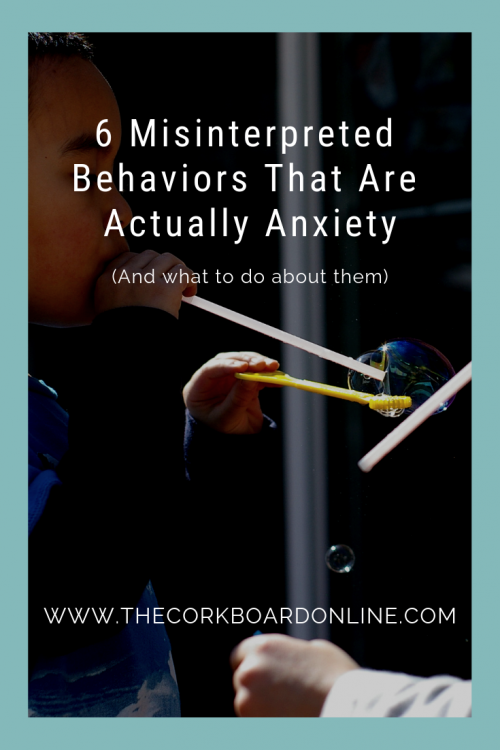One of the most common factors behind challenging behavior is anxiety. According to the Oxford Dictionary, anxiety is defined as, “a feeling of worry, nervousness, or unease about something with an uncertain outcome.”[1] The tricky thing is that anxiety isn’t always obvious. Sometimes anxiety in kids comes out in behaviors that may look disrespectful without a closer look.

Have you ever had a child giggle or laugh hysterically while you were trying to be stern? Makes your blood boil, right?
Maybe your child never stops moving. If he’s not running around the room, he’s drumming, tapping, or humming.
Have you ever seen a child get super silly or use a silly or high-pitched voice?
What about the kid who asks incessant questions? Or never shuts up.
Do you have a child who seems like a hypochondriac? Unending stomaches and headaches?
Maybe it’s a “bad” habit like biting her nails or sucking his thumb?
All of these behaviors, and more, are ways that anxiety builds up in our kids and then leaks out.
Once we recognize our child’s anxiety, we can be proactive about giving appropriate ways to relieve the build-up of anxiety. Think of these things as releasing a little anxiety at a time like the valve on your pressure cooker so that they don’t blow up!
Warm Water
Baths or showers can be very calming. For a while, we scheduled hour-long “therapy baths” into our son’s schedule that served as a respite for us (he was 6 so able to play without constant, direct supervision) and a calming tool for him–WIN! WIN! We use Epsom salt and essential oils, but they’re not necessary. If you have access to a therapy pool, all the better. Sometimes swimming (even if the water isn’t warm) does the trick, too.
Extended Exhales
This is one of the easiest ways to regulate excitatory neurotransmitters…no equipment needed. Some kids need help learning how to make their body do this. If you’re using the bath as a tool, try blowing bubbles in the bathtub or with a straw into a cup of water. Challenge your child to see how long he can blow without taking a breath. If we’re out and about, I’ll often try to get our son to try to blow me as far away from him as possible with one breath.
Essential Oils
Scents are the quickest way to impact the Limbic System in the brain. “Essential oils in the floral category are typically composed of monoterpene alcohols, which hold calming properties. Tree, herb, and grass oils are known to promote grounding, soothing emotions and feelings of renewal, as they primarily include sesquiterpenes, esters, and oxides.” [2] Keep a calming blend on hand for quick sniffs throughout the day and as needed. For more on using essential oils to calm anxious feelings, click here.
Nutrition
The majority of serotonin (the happy chemical) is produced in the gut. The gut also has more nerve cells than your spinal cord and sends more messages to the brain than it receives. What we eat matters when it comes to mood stability. Rather than jump on a bandwagon, start with a food journal. Document what goes in food-wise, and what comes out behaviorally. Try eliminating foods with artificial anything or try a week with just whole, unprocessed foods. Many individuals with trauma have compromised digestive systems which is why our kids may be more sensitive to foods and nutrition.
Exercise
We could all probably benefit from the serotonin released during exercise. Whether your child shows signs of depression or hyperactivity, exercise is the universal “fix.” If your child suffers from sensory issues, exercise can have a double benefit. Keep track of which types of movement seem to excite versus calm your child and use them appropriately.
Rather than seeing these as quick-fixes, remember they are the most effective if you incorporate them frequently in your routine. If your child is really struggling, you may want to break for some of these as often as every 2 hours.
Do you have a simple way that you use to decrease anxiety in your family?
References
[1] https://en.oxforddictionaries.com/definition/anxiety
[2] https://media.doterra.com/us/en/brochures/emotional-aromatherapy.pdf